Unit 4 Don't eat in class.Section A grammar focus-3c课件(共有PPT34张)
文档属性
| 名称 | Unit 4 Don't eat in class.Section A grammar focus-3c课件(共有PPT34张) | 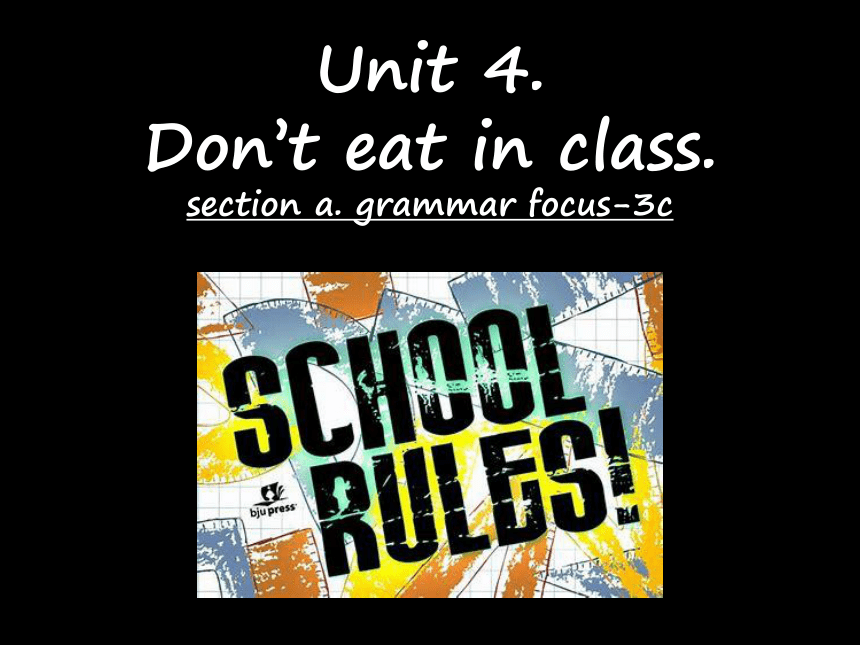 | |
| 格式 | zip | ||
| 文件大小 | 2.3MB | ||
| 资源类型 | 教案 | ||
| 版本资源 | 人教新目标(Go for it)版 | ||
| 科目 | 英语 | ||
| 更新时间 | 2022-03-12 09:27:41 | ||
图片预览

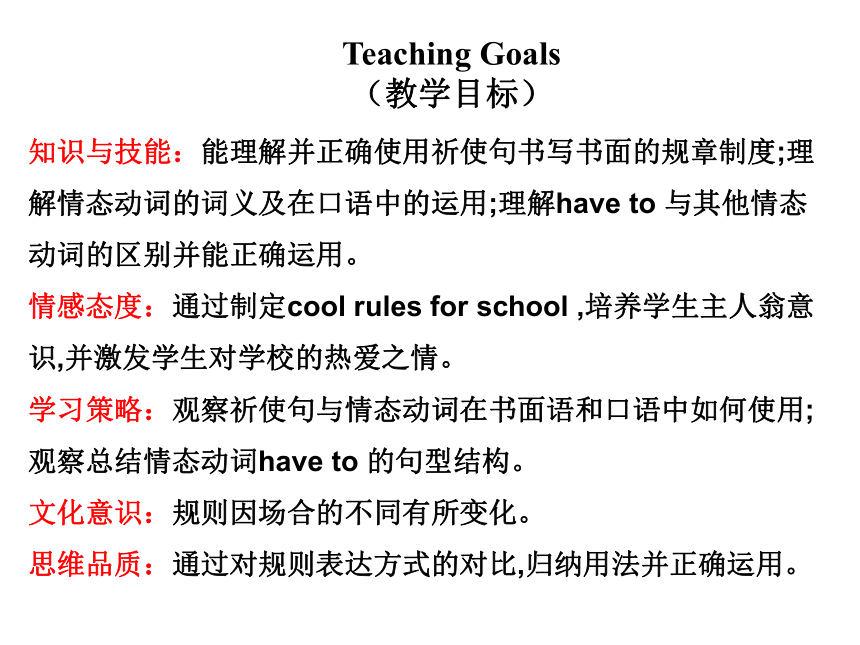


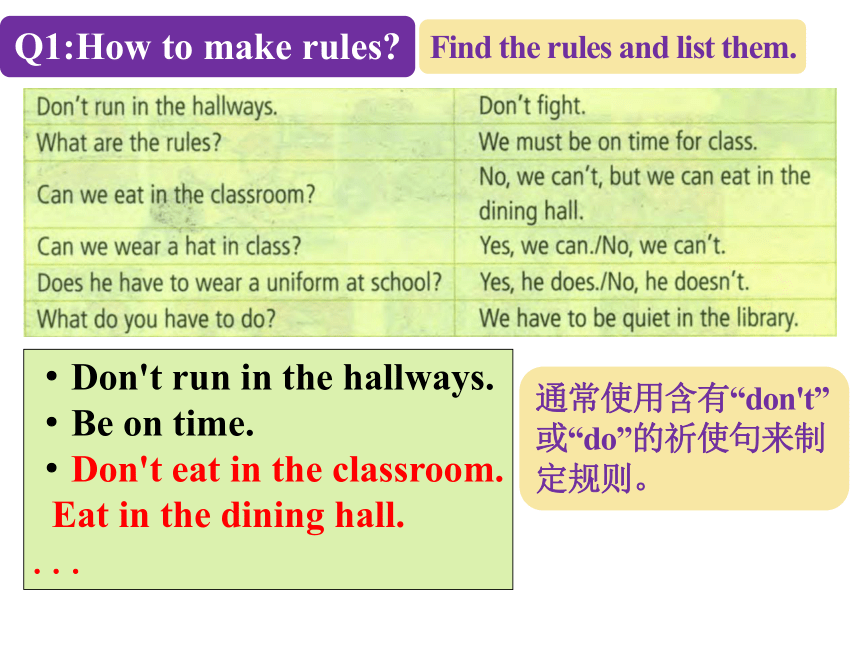
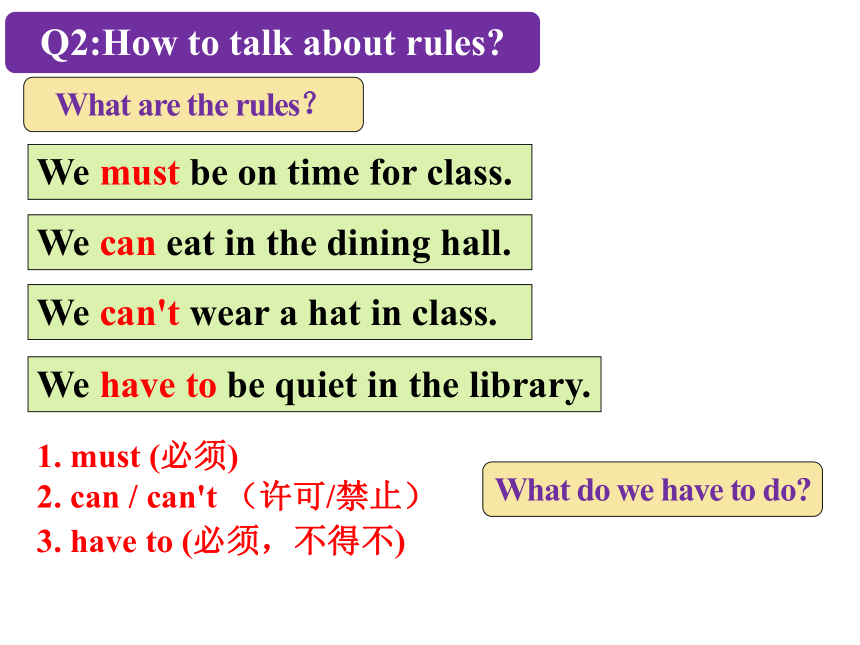
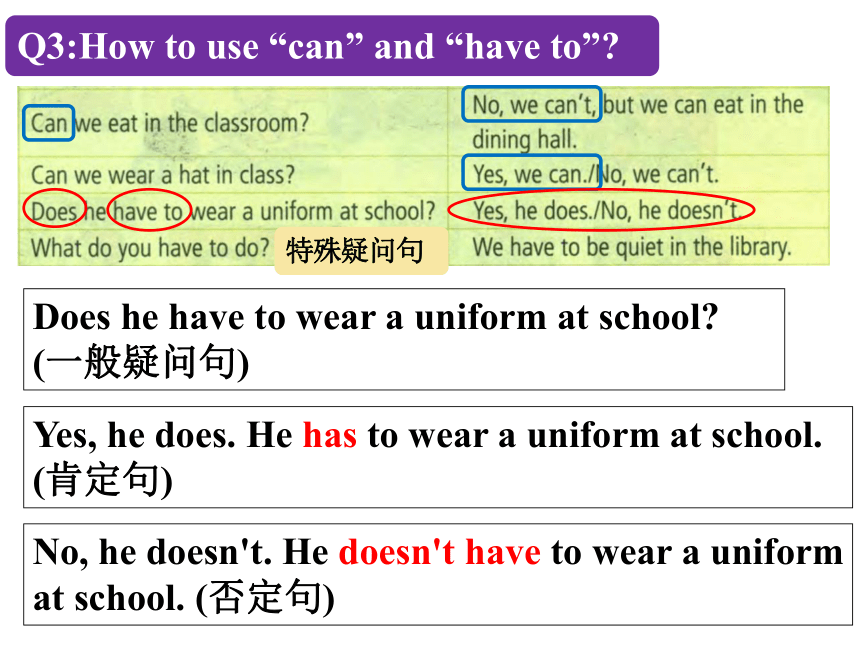
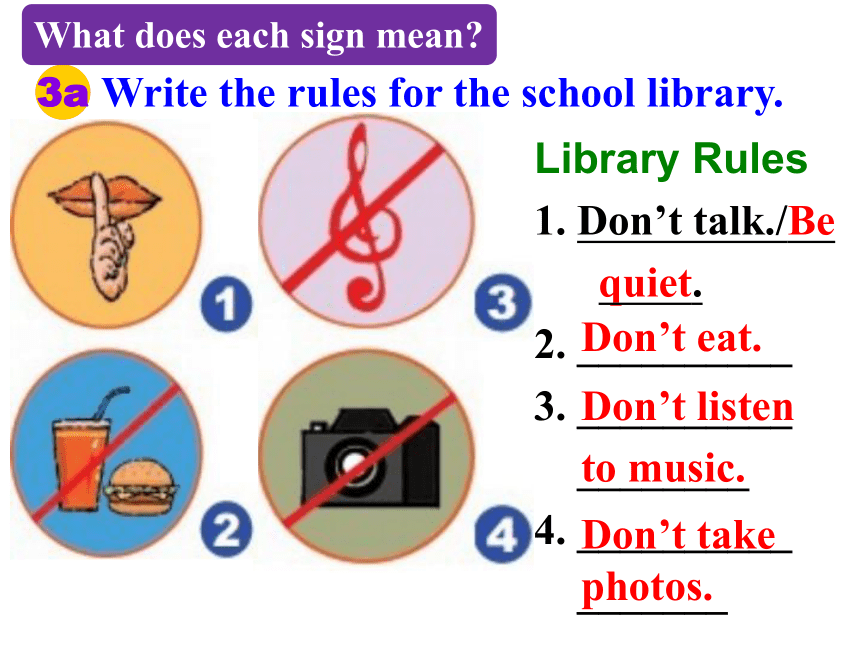
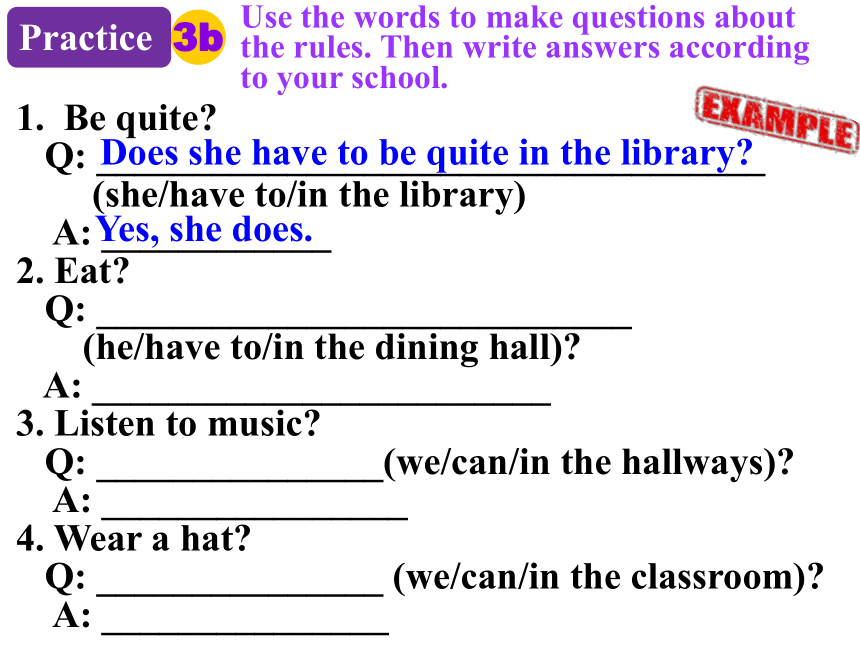

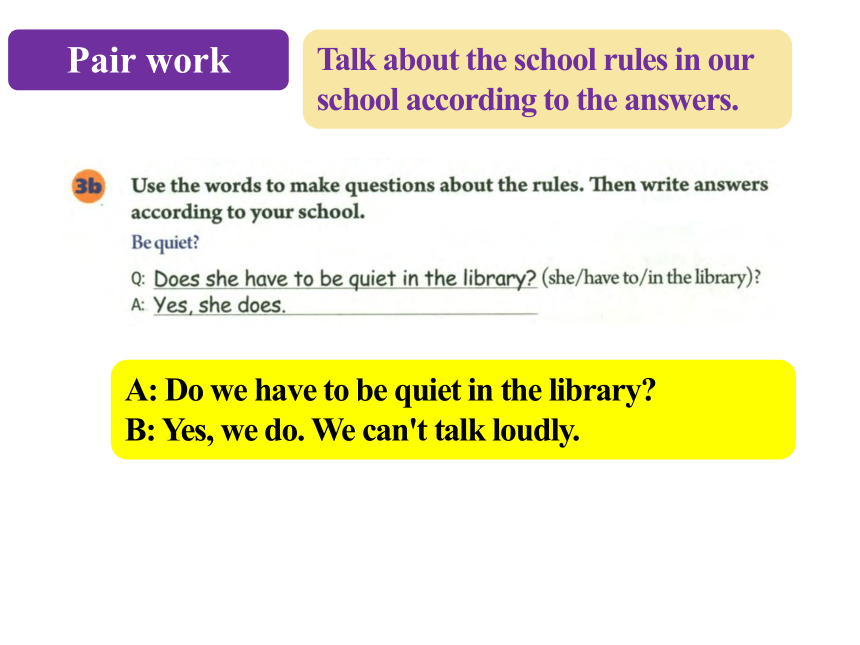
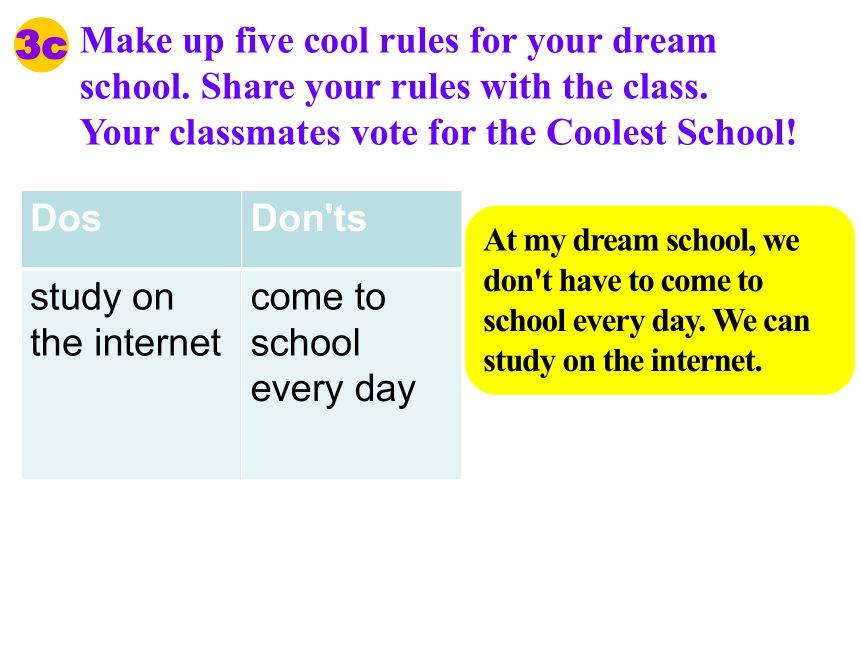
文档简介
(共34张PPT)
U
Unit 4.
Don’t eat in class.
section a. grammar focus-3c
知识与技能:能理解并正确使用祈使句书写书面的规章制度;理解情态动词的词义及在口语中的运用;理解have to 与其他情态动词的区别并能正确运用。
情感态度:通过制定cool rules for school ,培养学生主人翁意识,并激发学生对学校的热爱之情。
学习策略:观察祈使句与情态动词在书面语和口语中如何使用;观察总结情态动词have to 的句型结构。
文化意识:规则因场合的不同有所变化。
思维品质:通过对规则表达方式的对比,归纳用法并正确运用。
Teaching Goals
(教学目标)
Analysis of Teaching Materials
(教材分析)
Grammar Focus:祈使句否定结构;情态动词can;must;have to 意义及用法小结;总结询问及介绍规则的句型结构。
3a:根据图标提示,通过为校图书馆书写规则,巩固否定祈使句结构在书面语中的运用。
3b:通过造句练习巩固含有情态动词have to 和can的一般疑问句及回答。
3c:让学生为“理想中的学校”制定规则,通过个性化学习,激发学生运用语言,巩固目标语言结构。
各环节之间的联系:
语言结构总结→基本句型操练→语言输出
Pair work
Do you remember the rules at school or in our class Make a conversation to talk about them with your partners.
Q1:How to make rules
Find the rules and list them.
·Don't run in the hallways.
·Be on time.
·Don't eat in the classroom.
Eat in the dining hall.
...
通常使用含有“don't”或“do”的祈使句来制定规则。
Q2:How to talk about rules
What are the rules?
We must be on time for class.
We can eat in the dining hall.
We can't wear a hat in class.
We have to be quiet in the library.
1. must (必须)
2. can / can't (许可/禁止)
3. have to (必须,不得不)
What do we have to do
Q3:How to use “can” and “have to”
Does he have to wear a uniform at school (一般疑问句)
特殊疑问句
Yes, he does. He has to wear a uniform at school. (肯定句)
No, he doesn't. He doesn't have to wear a uniform at school. (否定句)
Library Rules
1. Don’t talk./Be quiet.
2. __________
3. __________
________
4. __________
_______
Don’t eat.
Write the rules for the school library.
Don’t listen to music.
Don’t take photos.
3a
What does each sign mean
Use the words to make questions about the rules. Then write answers according to your school.
3b
1. Be quite
Q: ___________________________________
(she/have to/in the library)
A: ____________
2. Eat
Q: ____________________________
(he/have to/in the dining hall)
A: ________________________
3. Listen to music
Q: _______________(we/can/in the hallways)
A: ________________
4. Wear a hat
Q: _______________ (we/can/in the classroom)
A: _______________
Does she have to be quite in the library
Yes, she does.
Practice
2. Eat
Q: ________________________________
(he/ have to/ in the dining hall)
A: _____________________
3. Listen to music
Q: ________________________________
(we/ can/ in the hallways)
A: ________________
4. Wear a hat
Q: _______________________________
(we/ can/ in the classroom)
A: _______________
Can we listen to music in the hallways
Can we wear a hat in the classroom
No, we can’t.
No, we can’t.
Does he have to eat in the dining hall
Yes, he does.
Check your answers.
Pair work
Talk about the school rules in our school according to the answers.
A: Do we have to be quiet in the library
B: Yes, we do. We can't talk loudly.
Make up five cool rules for your dream school. Share your rules with the class. Your classmates vote for the Coolest School!
3c
Dos Don'ts
study on the internet come to school every day
At my dream school, we don't have to come to school every day. We can study on the internet.
1. Don’t run in the hallways.
2.We must be on time for class.
3. - Can we eat in the classroom
-No, we can’t, but we can eat in the dining hall.
4. -Does he have to wear a uniform at school
- Yes, he does./ No, he doesn’t.
5. - What do you have to do
-We have to be quiet in the library.
课时重点回顾
Review
注: 另附word文档。
点击此处链接
Ⅰ. 用括号内所给单词的适当形式填空。
1. You can’t ______ (wear) a hat in class.
2. Let’s _______(play) soccer after school.
3. Don’t _______(run) in the hallways.
4. Mom, can you _____ (buy) a music player for me
5. My sister ______ (have) to get up early in the morning.
wear
play
run
buy
has
1. I can help you. (改为祈使句)
________ me ________ you.
2. You can’t arrive late for school. (改为祈使句)
________ ________ late for school.
3. Take these books to the classroom. (改为否定句)
________ ______ these books to the classroom.
4. They can eat in class. (改为一般疑问句)
________ they ________ in class
5. We have to wear sports shoes in P.E. classes. (对划线部分提问)
What ____ you _____ ______ ____ in P.E. classes
Don’t arrive
Ⅱ. 按要求完成句子,每空一词。
Let help
Don’t take
Can eat
do have to do
1. You can’t play the guitar at night.
______________________________
2. We can take some food to her.
______________________________
3. You must be quiet in the library.
______________________________
4. You can’t play soccer here.
______________________________
Ⅲ. 将下列句子改为祈使句。
Don’t play soccer here.
Don’t play the guitar at night.
Let’s take some food to her.
Be quiet in the library.
late, don’t, for school, arrive
2. music, listen to, in the classroom, don’t
3. eat, can’t, in the classroom, we
Ⅳ. 连词成句。
Don’t arrive late for school.
Don’t listen to music in the classroom.
We can’t eat in the classroom.
Homework
Find more rules like family rules, school rules, traffic rules or other rules in public places. List 2-3 rules of each kind.
祈使句
Focus on
基本用法
*祈使句的用法。
*祈使句的句型结构。
祈使句一般用于上级对下级,长辈对晚辈之间,表示命令、劝说或警告,也可表示请求。
*主语一般为第二人称,但通常省略。句末一般用句号,表示强烈语气时用感叹号。
祈使句
1) (You) go and tell him, Chris.
2) Look out! Danger!
注意:为使祈使句更委婉、有礼貌,可在祈使句开头或末尾加please。
1. 肯定祈使句的常见句型结构:
祈使句的句型结构
Let me help you.
Let’s play tennis.
Be a good boy!
Open the door, please.
③ Let型:Let+宾语+动词原形+其他.
② Be型:Be+表语.
① Do型:动词原形+宾语+其他.
2. 否定祈使句的常见句型结构:
① Do型和Be型的否定式:
Don’t+动词原形 / be+其他.
Don’t forget me.
Don’t be late.
② Let型的否定式:
Don’t+let+宾语+动词原形+其他.
Let’s+not+动词原形+其他.
Don’t let him go back.
Let’s not go swimming.
③ 警示语:No+名词/V-ing.
No talking.
将下面的句子改为祈使句,每空一词。
1. You can come in.
_____ ____, please.
2. I can help you.
____ me _____ you.
3. You can’t eat in class.
_____ _____ in class.
4. You can’t be late for school.
_____ ____ late for school.
5. You can’t talk in the library.
_____ talking in the library.
Come in
Let help
Don’t eat
Don’t be
No
Practice
情态动词can, must & have to
Focus on
基本用法
*情态动词must的用法及句型结构;
*情态动词have to的用法及句型结构。
*情态动词can的用法及句型结构;
1. 本单元中can 意为“可以”,表示请求、允许。
I can dance and sing.
情态动词 can
2. Can还可表示能力,意为“能,会”。
1) -Can the students run in the hallways
-Yes, they can./No, they can’t.
2) We can’t eat in the classroom.
情态动词can的句型结构:
1) I can dance and sing.
2) We can’t eat in the classroom.
3) -Can the students run in the hallways
-Yes, they can.
No, they can’t.
肯定: 主语+can+V原形+其他.
否定:主语+can not/can’t+V原形+其他.
疑问句: Can+主语+V原形+其他
肯定回答:Yes, 主语+can.
否定回答:No, 主语+can’t.
情态动词must表说话人的主观看法,表示必须、必要。无人称和数的变化 ,不能单独使用,必须与其后的动词原形构成谓语。
情态动词must
1) You must come in time.
你必须按时来。
2) I must get some sleep.
我必须睡会儿觉了。
句型结构:主语+must+V原形+其他.
must的句型结构:
1. Everyone must obey the rule.
2. You mustn’t speak like that.
3. - Must I be home before 8 o’clock
-Yes, you must.
-No, you needn’t./No, you don’t have to.
肯定:主语+must+V原形+其他.
否定:主语+mustn’t/must not+V原形+其他.
疑问句: Must+主语+V原形+其他
肯定回答: Yes, 主语+must.
否定回答: No, 主语+needn’t/don’t have to.
must not表示“不应该”、“禁止”、“不准”。语气比较强烈。
情态动词have to
have to 表示必须,强调客观需要,有不得不、被逼无奈做某事的意思。
它既有人称、单复数的变化、也有动词时态的变化。
其否定形式和疑问句形式均需要借助助动词do才可以进行变化。
have to的句型结构:
1. She has to look after her mother at home.
2. We don’t have to clean the room today.
3. -Does he have to go to bed now
-Yes, he does.
-No, he doesn’t.
肯定:主语+have/has/had to+V原形+其他
否定:主语+don’t/doesn’t/didn’t have to+V原形+其他
疑问句: Do/Does/Did+主语+have to+V原形+其他
肯定回答:Yes, 主语+do/does/did.
否定回答:No, 主语+don’t/doesn’t/didn’t.
相同点
不同点
must
have to
must通常表示说话人的主观看法,语气比较强烈,have to 往往强调客观需要。
表示“必须”,有时二者可互换。
We have to/must follow the rules.
它们的否定式含义大不相同。mustn’t表示“不准;禁止”,don’t have to表示“不必”。
*I must go now.
*It’s a little late and I have to go now.
*You mustn’t talk to your mother like that.
*You don’t have to come if you don’t want to.
must一般只表示现在,没有人称和数的变化。
而have to则可以用于不同的时态,有人称和数的变化。
*You mustn’t talk to your mother like that.
*You don’t have to come if you don’t want to.
There is nothing in the fridge. I ________ go shopping now.
It’s very warm. You ______________ (不必) wear the coat.
have to
don’t have to
根据所给提示用must, have to, can的恰当形式填空。
Practice
-_____ we wear hats in school
-Yes, we can.
Can
We _______ protect our environment.
must
U
Unit 4.
Don’t eat in class.
section a. grammar focus-3c
知识与技能:能理解并正确使用祈使句书写书面的规章制度;理解情态动词的词义及在口语中的运用;理解have to 与其他情态动词的区别并能正确运用。
情感态度:通过制定cool rules for school ,培养学生主人翁意识,并激发学生对学校的热爱之情。
学习策略:观察祈使句与情态动词在书面语和口语中如何使用;观察总结情态动词have to 的句型结构。
文化意识:规则因场合的不同有所变化。
思维品质:通过对规则表达方式的对比,归纳用法并正确运用。
Teaching Goals
(教学目标)
Analysis of Teaching Materials
(教材分析)
Grammar Focus:祈使句否定结构;情态动词can;must;have to 意义及用法小结;总结询问及介绍规则的句型结构。
3a:根据图标提示,通过为校图书馆书写规则,巩固否定祈使句结构在书面语中的运用。
3b:通过造句练习巩固含有情态动词have to 和can的一般疑问句及回答。
3c:让学生为“理想中的学校”制定规则,通过个性化学习,激发学生运用语言,巩固目标语言结构。
各环节之间的联系:
语言结构总结→基本句型操练→语言输出
Pair work
Do you remember the rules at school or in our class Make a conversation to talk about them with your partners.
Q1:How to make rules
Find the rules and list them.
·Don't run in the hallways.
·Be on time.
·Don't eat in the classroom.
Eat in the dining hall.
...
通常使用含有“don't”或“do”的祈使句来制定规则。
Q2:How to talk about rules
What are the rules?
We must be on time for class.
We can eat in the dining hall.
We can't wear a hat in class.
We have to be quiet in the library.
1. must (必须)
2. can / can't (许可/禁止)
3. have to (必须,不得不)
What do we have to do
Q3:How to use “can” and “have to”
Does he have to wear a uniform at school (一般疑问句)
特殊疑问句
Yes, he does. He has to wear a uniform at school. (肯定句)
No, he doesn't. He doesn't have to wear a uniform at school. (否定句)
Library Rules
1. Don’t talk./Be quiet.
2. __________
3. __________
________
4. __________
_______
Don’t eat.
Write the rules for the school library.
Don’t listen to music.
Don’t take photos.
3a
What does each sign mean
Use the words to make questions about the rules. Then write answers according to your school.
3b
1. Be quite
Q: ___________________________________
(she/have to/in the library)
A: ____________
2. Eat
Q: ____________________________
(he/have to/in the dining hall)
A: ________________________
3. Listen to music
Q: _______________(we/can/in the hallways)
A: ________________
4. Wear a hat
Q: _______________ (we/can/in the classroom)
A: _______________
Does she have to be quite in the library
Yes, she does.
Practice
2. Eat
Q: ________________________________
(he/ have to/ in the dining hall)
A: _____________________
3. Listen to music
Q: ________________________________
(we/ can/ in the hallways)
A: ________________
4. Wear a hat
Q: _______________________________
(we/ can/ in the classroom)
A: _______________
Can we listen to music in the hallways
Can we wear a hat in the classroom
No, we can’t.
No, we can’t.
Does he have to eat in the dining hall
Yes, he does.
Check your answers.
Pair work
Talk about the school rules in our school according to the answers.
A: Do we have to be quiet in the library
B: Yes, we do. We can't talk loudly.
Make up five cool rules for your dream school. Share your rules with the class. Your classmates vote for the Coolest School!
3c
Dos Don'ts
study on the internet come to school every day
At my dream school, we don't have to come to school every day. We can study on the internet.
1. Don’t run in the hallways.
2.We must be on time for class.
3. - Can we eat in the classroom
-No, we can’t, but we can eat in the dining hall.
4. -Does he have to wear a uniform at school
- Yes, he does./ No, he doesn’t.
5. - What do you have to do
-We have to be quiet in the library.
课时重点回顾
Review
注: 另附word文档。
点击此处链接
Ⅰ. 用括号内所给单词的适当形式填空。
1. You can’t ______ (wear) a hat in class.
2. Let’s _______(play) soccer after school.
3. Don’t _______(run) in the hallways.
4. Mom, can you _____ (buy) a music player for me
5. My sister ______ (have) to get up early in the morning.
wear
play
run
buy
has
1. I can help you. (改为祈使句)
________ me ________ you.
2. You can’t arrive late for school. (改为祈使句)
________ ________ late for school.
3. Take these books to the classroom. (改为否定句)
________ ______ these books to the classroom.
4. They can eat in class. (改为一般疑问句)
________ they ________ in class
5. We have to wear sports shoes in P.E. classes. (对划线部分提问)
What ____ you _____ ______ ____ in P.E. classes
Don’t arrive
Ⅱ. 按要求完成句子,每空一词。
Let help
Don’t take
Can eat
do have to do
1. You can’t play the guitar at night.
______________________________
2. We can take some food to her.
______________________________
3. You must be quiet in the library.
______________________________
4. You can’t play soccer here.
______________________________
Ⅲ. 将下列句子改为祈使句。
Don’t play soccer here.
Don’t play the guitar at night.
Let’s take some food to her.
Be quiet in the library.
late, don’t, for school, arrive
2. music, listen to, in the classroom, don’t
3. eat, can’t, in the classroom, we
Ⅳ. 连词成句。
Don’t arrive late for school.
Don’t listen to music in the classroom.
We can’t eat in the classroom.
Homework
Find more rules like family rules, school rules, traffic rules or other rules in public places. List 2-3 rules of each kind.
祈使句
Focus on
基本用法
*祈使句的用法。
*祈使句的句型结构。
祈使句一般用于上级对下级,长辈对晚辈之间,表示命令、劝说或警告,也可表示请求。
*主语一般为第二人称,但通常省略。句末一般用句号,表示强烈语气时用感叹号。
祈使句
1) (You) go and tell him, Chris.
2) Look out! Danger!
注意:为使祈使句更委婉、有礼貌,可在祈使句开头或末尾加please。
1. 肯定祈使句的常见句型结构:
祈使句的句型结构
Let me help you.
Let’s play tennis.
Be a good boy!
Open the door, please.
③ Let型:Let+宾语+动词原形+其他.
② Be型:Be+表语.
① Do型:动词原形+宾语+其他.
2. 否定祈使句的常见句型结构:
① Do型和Be型的否定式:
Don’t+动词原形 / be+其他.
Don’t forget me.
Don’t be late.
② Let型的否定式:
Don’t+let+宾语+动词原形+其他.
Let’s+not+动词原形+其他.
Don’t let him go back.
Let’s not go swimming.
③ 警示语:No+名词/V-ing.
No talking.
将下面的句子改为祈使句,每空一词。
1. You can come in.
_____ ____, please.
2. I can help you.
____ me _____ you.
3. You can’t eat in class.
_____ _____ in class.
4. You can’t be late for school.
_____ ____ late for school.
5. You can’t talk in the library.
_____ talking in the library.
Come in
Let help
Don’t eat
Don’t be
No
Practice
情态动词can, must & have to
Focus on
基本用法
*情态动词must的用法及句型结构;
*情态动词have to的用法及句型结构。
*情态动词can的用法及句型结构;
1. 本单元中can 意为“可以”,表示请求、允许。
I can dance and sing.
情态动词 can
2. Can还可表示能力,意为“能,会”。
1) -Can the students run in the hallways
-Yes, they can./No, they can’t.
2) We can’t eat in the classroom.
情态动词can的句型结构:
1) I can dance and sing.
2) We can’t eat in the classroom.
3) -Can the students run in the hallways
-Yes, they can.
No, they can’t.
肯定: 主语+can+V原形+其他.
否定:主语+can not/can’t+V原形+其他.
疑问句: Can+主语+V原形+其他
肯定回答:Yes, 主语+can.
否定回答:No, 主语+can’t.
情态动词must表说话人的主观看法,表示必须、必要。无人称和数的变化 ,不能单独使用,必须与其后的动词原形构成谓语。
情态动词must
1) You must come in time.
你必须按时来。
2) I must get some sleep.
我必须睡会儿觉了。
句型结构:主语+must+V原形+其他.
must的句型结构:
1. Everyone must obey the rule.
2. You mustn’t speak like that.
3. - Must I be home before 8 o’clock
-Yes, you must.
-No, you needn’t./No, you don’t have to.
肯定:主语+must+V原形+其他.
否定:主语+mustn’t/must not+V原形+其他.
疑问句: Must+主语+V原形+其他
肯定回答: Yes, 主语+must.
否定回答: No, 主语+needn’t/don’t have to.
must not表示“不应该”、“禁止”、“不准”。语气比较强烈。
情态动词have to
have to 表示必须,强调客观需要,有不得不、被逼无奈做某事的意思。
它既有人称、单复数的变化、也有动词时态的变化。
其否定形式和疑问句形式均需要借助助动词do才可以进行变化。
have to的句型结构:
1. She has to look after her mother at home.
2. We don’t have to clean the room today.
3. -Does he have to go to bed now
-Yes, he does.
-No, he doesn’t.
肯定:主语+have/has/had to+V原形+其他
否定:主语+don’t/doesn’t/didn’t have to+V原形+其他
疑问句: Do/Does/Did+主语+have to+V原形+其他
肯定回答:Yes, 主语+do/does/did.
否定回答:No, 主语+don’t/doesn’t/didn’t.
相同点
不同点
must
have to
must通常表示说话人的主观看法,语气比较强烈,have to 往往强调客观需要。
表示“必须”,有时二者可互换。
We have to/must follow the rules.
它们的否定式含义大不相同。mustn’t表示“不准;禁止”,don’t have to表示“不必”。
*I must go now.
*It’s a little late and I have to go now.
*You mustn’t talk to your mother like that.
*You don’t have to come if you don’t want to.
must一般只表示现在,没有人称和数的变化。
而have to则可以用于不同的时态,有人称和数的变化。
*You mustn’t talk to your mother like that.
*You don’t have to come if you don’t want to.
There is nothing in the fridge. I ________ go shopping now.
It’s very warm. You ______________ (不必) wear the coat.
have to
don’t have to
根据所给提示用must, have to, can的恰当形式填空。
Practice
-_____ we wear hats in school
-Yes, we can.
Can
We _______ protect our environment.
must
同课章节目录
- Unit 1 Can you play the guitar?
- Section A
- Section B
- Unit 2 What time do you go to school?
- Section A
- Section B
- Unit 3 How do you get to school?
- Section A
- Section B
- Unit 4 Don't eat in class.
- Section A
- Section B
- Unit 5 Why do you like pandas?
- Section A
- Section B
- Unit 6 I'm watching TV.
- Section A
- Section B
- Review of Units 1-6
- Unit 7 It's raining!
- Section A
- Section B
- Unit 8 Is there a post office near here?
- Section A
- Section B
- Unit 9 What does he look like?
- Section A
- Section B
- Unit 10 I'd like some noodles.
- Section A
- Section B
- Unit 11 How was your school trip?
- Section A
- Section B
- Unit 12 What did you do last weekend?
- Section A
- Section B
